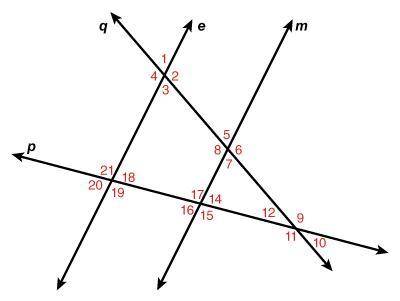
Mathematics, 20.04.2020 22:38 shawn20034
In the diagram, lines e and m are parallel to each other and lines p and q are transversals. Use properties of special angles, formed by parallel lines and their transversals, to describe the relationship between the angles. Note: Figure is not drawn to scale.
e || m ; lines p and q are transversals
m< 3 = 65
m <15=120
<6 and <4 are _ angles.
<6 and <2 are_ angles.
<5 and <7 are_ angles.
<19 and <17 are_ angles.
<9 and <11 are_ angles.
<21 and <15 are_ angles.
<17 and <14 are_ angles.
< 3 and <18 are_ angles .


Answers: 2


Another question on Mathematics

Mathematics, 21.06.2019 19:30
Choose the more precise measurement. 26.4 cm or 8.39 cm
Answers: 1

Mathematics, 21.06.2019 21:50
Rachel is studying the population of a particular bird species in a national park. she observes every 10th bird of that species that she can find in the park. her conclusion is that the birds living in the park who belong to that species generally feed on insects. rachel's sample is . based on the sample she picked, rachel's generalization is . reset next
Answers: 1

Mathematics, 21.06.2019 23:00
The equation shown below represents function f. f(x)= -2x+5 the graph shown below represents function g. which of the following statements is true? a. over the interval [2, 4], the average rate of change of f is the same as the average rate of change of g. the y-intercept of function f is less than the y-intercept of function g. b. over the interval [2, 4], the average rate of change of f is greater than the average rate of change of g. the y-intercept of function f is greater than the y-intercept of function g. c. over the interval [2, 4], the average rate of change of f is the same as the average rate of change of g. the y-intercept of function f is greater than the y-intercept of function g. d. over the interval [2, 4], the average rate of change of f is less than the average rate of change of g. the y-intercept of function f is the same as the y-intercept of function g.
Answers: 1

Mathematics, 22.06.2019 01:30
(01.02 mc) asap plzzzwhich of the following correctly simplifies the expression 3 to the power of 2 multiplied by 5 to the power of 0 whole over 4, the whole squared.? select one: a. 3 to the power of 2 multiplied by 1 whole over 4, the whole squared. = 3 to the power of 1 multiplied by 1 squared over 4 squared. = 1 over 6.b. 3 to the power of 2 multiplied by 0 whole over 4, the whole squared. = 3 to the power of 4 multiplied by 0 over 4 squared. = 0c. 3 to the power of 2 multiplied by 0 whole over 4, the whole squared. = 3 to the power of 1 multiplied by 0 over 4 squared. = 0d. 3 to the power of 2 multiplied by 1 whole over 4, the whole squared. = 3 to the power of 4 multiplied by 1 squared over 4 squared. = 81 over 16.
Answers: 1
You know the right answer?
In the diagram, lines e and m are parallel to each other and lines p and q are transversals. Use pro...
Questions



English, 04.08.2019 22:30


Advanced Placement (AP), 04.08.2019 22:30



Biology, 04.08.2019 22:30


Mathematics, 04.08.2019 22:30




Social Studies, 04.08.2019 22:30





Social Studies, 04.08.2019 22:30

Biology, 04.08.2019 22:30



